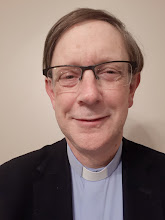I woke early this morning and decided to get up and wash some clothes. When I got up to the laundry on the roof I looked out over the city and saw the moon going down behind the Church of the Holy Sepulchre.
In the morning we had a lecture on the theology, and some of the history, of icons by the Dean of the College, Stephen Need. This included an interesting outline of the debate relating to the use of icons in worship. It was very interesting to hear a little about the theological issues that the use of icons brought up. A beautiful quotation from John of Damascus – one of the key spokesmen for the group that favoured the use of icons (the iconophiles) was , “I do not worship matter. I worship the Creator of matter who became matter for my sake.”
For him and many others, especially those in the Eastern Orthodox tradition, icons are a holy space through which one can enter into the presence of God and of God's saints in heaven. After the lecture we went into the old city to view a contemporary icon exhibition (no pictures allowed owing to copyright). After lunch we went on to the Greek Catholic (Melkite) Church, which had beautiful frescos as well as many icons. There the course assistant, Ben Drury, gave a good talk on the interior design of Eastern Orthodox churches.
For him and many others, especially those in the Eastern Orthodox tradition, icons are a holy space through which one can enter into the presence of God and of God's saints in heaven. After the lecture we went into the old city to view a contemporary icon exhibition (no pictures allowed owing to copyright). After lunch we went on to the Greek Catholic (Melkite) Church, which had beautiful frescos as well as many icons. There the course assistant, Ben Drury, gave a good talk on the interior design of Eastern Orthodox churches.
In the centre is Christ, as if looking down from heaven. His picture is held by angels. Then on the next level are angels and cherubim worshipping God/Christ. And on the final level are God's saints. These are apparently the standard design and themes of cupolas in the Eastern tradition. As is typical, the church was highly decorated, both with an iconostasis and with frescos all over the walls and ceilings.
An example of the icons was this one - of Mary the Mother of God (Theotokos) and Jesus.
The frescos around the church depicted scenes from Jesus' life and various saints. Here is a close up of one of the frescos. This one is of the wedding of Cana.
In the afternoon we had a lecture on the themes of the Passion, in the Eastern Orthodox tradition. It was given by Andrew Mayes, the Course Director. It gave good insights into what we will be sharing in with the liturgies of the next few days. In the Eastern tradition, the Passion, death and resurrection of Jesus are seen not so much as a sad and then wonderful story. Rather, they are seen as the purposeful victory of God over the Evil One, and over the powers of sin and death.
In the evening we had a very interesting lecture by George Hinthlian, the former Secretary of the Armenian Patriarch, about the Holy Fire ceremony. George talked about some of its turbulent history and its current state, and helped us understand what would be happening at the Holy Fire ceremony on Easter Eve.
In the evening we had a very interesting lecture by George Hinthlian, the former Secretary of the Armenian Patriarch, about the Holy Fire ceremony. George talked about some of its turbulent history and its current state, and helped us understand what would be happening at the Holy Fire ceremony on Easter Eve.






No comments:
Post a Comment